Top 10 Foods Highest in Vitamin B12
Top 10 Foods Highest in Vitamin B12 (Cobalamin)
| Borrowed from Google search which yielded me an article from online at: http://www.healthaliciousness.com/articles/foods-high-in-vitamin-B12.php |
#1: Clams, Oysters, and Mussels
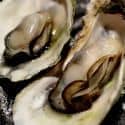 Shellfish are a great source of vitamin B12 and can be eaten raw, baked,
steamed, fried, or made into chowder. In addition to vitamin B12
shellfish are a good source of
zinc,
copper, and
iron.
Clams provide the most vitamin B-12 with 98.9μg per 100g serving, accounting for 1648% of the DV. That is
84μg (1401% DV) per 3 ounce serving, and 187.9μg (3132% DV) in 20 small clams, or 9.4μg (156.6 %DV) in
one small clam. Mussels and oysters are also good sources of B12 providing 600% DV and 400% DV per 100 gram serving.
Click to see complete nutrition facts.
Shellfish are a great source of vitamin B12 and can be eaten raw, baked,
steamed, fried, or made into chowder. In addition to vitamin B12
shellfish are a good source of
zinc,
copper, and
iron.
Clams provide the most vitamin B-12 with 98.9μg per 100g serving, accounting for 1648% of the DV. That is
84μg (1401% DV) per 3 ounce serving, and 187.9μg (3132% DV) in 20 small clams, or 9.4μg (156.6 %DV) in
one small clam. Mussels and oysters are also good sources of B12 providing 600% DV and 400% DV per 100 gram serving.
Click to see complete nutrition facts.
#2: Liver
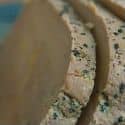 Often appearing on the culinary scene as pâté, liver can also be prepared steamed or
fried with onions and herbs. The liver of most any animal is packed with vitamin B-12, the highest on the list are:
Lamb, beef, veal, moose, turkey, duck, and goose respectively.
Lamb liver provides 85.7μg (1428% DV) of vitamin B12 per 100g serving, or 72.85μg (230% DV) in a 3 ounce serving.
Click to see complete nutrition facts.
Often appearing on the culinary scene as pâté, liver can also be prepared steamed or
fried with onions and herbs. The liver of most any animal is packed with vitamin B-12, the highest on the list are:
Lamb, beef, veal, moose, turkey, duck, and goose respectively.
Lamb liver provides 85.7μg (1428% DV) of vitamin B12 per 100g serving, or 72.85μg (230% DV) in a 3 ounce serving.
Click to see complete nutrition facts.
#3: Caviar (Fish Eggs)
 Caviar and fish eggs are most often eaten as a garnish or spread.
The eggs of whitefish contain the most vitamin B-12 with 56.4μg (940%
DV) per 100g serving. Caviar contains a third of that with 20μg (333%
DV) of vitamin B12 per 100g serving, 5.6μg (93% DV) per ounce,
and 3.2μg (53% DV) per tablespoon.
Chicken eggs, by comparison, only offer 1.29μg (22% DV) of vitamin B-12
per 100g serving, or
0.65μg (11% DV) per egg.
Click to see complete nutrition facts. Buy Caviar from Amazon.com
Caviar and fish eggs are most often eaten as a garnish or spread.
The eggs of whitefish contain the most vitamin B-12 with 56.4μg (940%
DV) per 100g serving. Caviar contains a third of that with 20μg (333%
DV) of vitamin B12 per 100g serving, 5.6μg (93% DV) per ounce,
and 3.2μg (53% DV) per tablespoon.
Chicken eggs, by comparison, only offer 1.29μg (22% DV) of vitamin B-12
per 100g serving, or
0.65μg (11% DV) per egg.
Click to see complete nutrition facts. Buy Caviar from Amazon.com
#4: Octopus
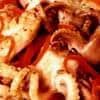 Popular in Mediterranean, Japanese, and Hawaiian cuisine, octopus is a vitamin b12 rich food. Cooked octopus provides 36μg of
vitamin B-12 per 100 gram serving accounting for 600% of the DV. That is 30.6μg (510% DV) per 3 ounce serving,
or 10.2μg (170% DV) per ounce. Raw octopus provides about half as much vitamin b12 with 20μg (333% DV) per 100 gram serving,
17μg (283% DV) in a 3 ounce serving, and 5.67μg (94.33% DV) per ounce.
Click to see complete nutrition facts.
Popular in Mediterranean, Japanese, and Hawaiian cuisine, octopus is a vitamin b12 rich food. Cooked octopus provides 36μg of
vitamin B-12 per 100 gram serving accounting for 600% of the DV. That is 30.6μg (510% DV) per 3 ounce serving,
or 10.2μg (170% DV) per ounce. Raw octopus provides about half as much vitamin b12 with 20μg (333% DV) per 100 gram serving,
17μg (283% DV) in a 3 ounce serving, and 5.67μg (94.33% DV) per ounce.
Click to see complete nutrition facts.
#5: Fish
 Known for their omega 3 fats and for being a
high protein food, fish are also a good source of vitamin B12.
Mackerel provides the most vitamin B-12 with 19μg per 100g serving (317% DV), followed by Herring (312% DV),
Salmon (302%), Tuna (181%), Cod (167%), Sardines (149%), Trout (130%),
and Bluefish (104%).
Known for their omega 3 fats and for being a
high protein food, fish are also a good source of vitamin B12.
Mackerel provides the most vitamin B-12 with 19μg per 100g serving (317% DV), followed by Herring (312% DV),
Salmon (302%), Tuna (181%), Cod (167%), Sardines (149%), Trout (130%),
and Bluefish (104%).
Click to see complete nutrition facts. Canned Fish Highest in Vitamin B12.
#6: Crab and Lobster
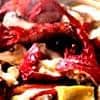 Crab and lobster are most commonly served baked, steamed, or in bisque. A
100g serving of
crab contains 11.5μg of vitamin B12 (192% of the DV), that is 15.4μg
(257%DV) per leg (134g). Lobster will provide 4.04μg(67% DV) per 100g
serving, or 6.59μg (110% DV) in an average whole lobster (163g).
Crab and lobster are most commonly served baked, steamed, or in bisque. A
100g serving of
crab contains 11.5μg of vitamin B12 (192% of the DV), that is 15.4μg
(257%DV) per leg (134g). Lobster will provide 4.04μg(67% DV) per 100g
serving, or 6.59μg (110% DV) in an average whole lobster (163g).
Click to see complete nutrition facts.
#7: Beef
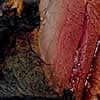 In addition to being a vitamin B12 rich food, beef is also a good source of
protein,
zinc, and
heme-iron.
The amount of vitamin B-12 in beef depends on the cut, lean fat-trimmed
chuck contains the most vitamin B12 with 6.18μg (103% DV) per 100g
serving, 11.49μg (103% DV) in a chuck steak, and 5.25μg (88% DV) in a 3
ounce serving.
Chuck is followed by sirloin (62% DV), rib-eye (60% DV), and ribs (58%
DV).
In addition to being a vitamin B12 rich food, beef is also a good source of
protein,
zinc, and
heme-iron.
The amount of vitamin B-12 in beef depends on the cut, lean fat-trimmed
chuck contains the most vitamin B12 with 6.18μg (103% DV) per 100g
serving, 11.49μg (103% DV) in a chuck steak, and 5.25μg (88% DV) in a 3
ounce serving.
Chuck is followed by sirloin (62% DV), rib-eye (60% DV), and ribs (58%
DV).
Click to see complete nutrition facts.
#8: Lamb (Mutton)
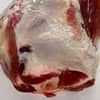 Lamb is a common meat in the Middle East, Mediterranean, East Asia, Australia, New Zealand, and most of Europe.
Lamb is a
high cholesterol food
so be sure to look for lean cuts which are higher in B12 anyway. Lamb
also provides high amounts of
protein,
and zinc.
The shoulder is the cut of lamb with the most vitamin B-12 providing
3.71μg (62% DV) per 100g serving, 5.82μg (97% DV) per pound,
and 3.15μg (53% DV) in a 3 ounce serving.
The shoulder is followed by the foreshank and leg which provides 53% of
the DV per 100g serving, and lamb chops which provide 51% of the DV for
vitmain B12 per 100 gram serving.
Click to see complete nutrition facts.
Lamb is a common meat in the Middle East, Mediterranean, East Asia, Australia, New Zealand, and most of Europe.
Lamb is a
high cholesterol food
so be sure to look for lean cuts which are higher in B12 anyway. Lamb
also provides high amounts of
protein,
and zinc.
The shoulder is the cut of lamb with the most vitamin B-12 providing
3.71μg (62% DV) per 100g serving, 5.82μg (97% DV) per pound,
and 3.15μg (53% DV) in a 3 ounce serving.
The shoulder is followed by the foreshank and leg which provides 53% of
the DV per 100g serving, and lamb chops which provide 51% of the DV for
vitmain B12 per 100 gram serving.
Click to see complete nutrition facts.
#9: Cheese
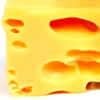 Despite being a
high cholesterol food,
cheese is a good source of
calcium,
protein, and
Riboflavin (Vitamin B2).
The amount of vitamin B12 in cheese depends on type and variety, Swiss cheese provides the most
with 3.34μg (56% DV) per 100g serving, followed by Gjetost (40% DV), Mozzarella(39% DV),
Parmesan (38% DV), Tilsit (35% DV), and Feta (28% DV).
Click to see complete nutrition facts.
Despite being a
high cholesterol food,
cheese is a good source of
calcium,
protein, and
Riboflavin (Vitamin B2).
The amount of vitamin B12 in cheese depends on type and variety, Swiss cheese provides the most
with 3.34μg (56% DV) per 100g serving, followed by Gjetost (40% DV), Mozzarella(39% DV),
Parmesan (38% DV), Tilsit (35% DV), and Feta (28% DV).
Click to see complete nutrition facts.
#10: Eggs
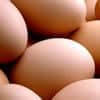 When it comes to chicken eggs the raw yellow has most of the vitamin B-12 with 1.95μg per 100g
serving (33%), however, this equates to 0.33μg per yolk or just 6% of the DV.
The eggs of other animals are higher with a goose egg providing 7.34μg (122% DV) of
vitamin B-12 per 100g serving, and a duck egg providing 3.78μg (63% DV).
When it comes to chicken eggs the raw yellow has most of the vitamin B-12 with 1.95μg per 100g
serving (33%), however, this equates to 0.33μg per yolk or just 6% of the DV.
The eggs of other animals are higher with a goose egg providing 7.34μg (122% DV) of
vitamin B-12 per 100g serving, and a duck egg providing 3.78μg (63% DV).
Click to see complete nutrition facts.
Labels: anemaia, B-12, Cobalamine, complexity, depression, diet, fatigue, health, importance, mania, Tess-Anderson, top-10-foods, Vitamins











